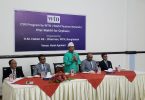صدر جي فيڊريشن آف انڊين چيمبر آف ڪامرس اينڊ انڊسٽري (FICCI)، Dr. Sangita Reddy, said yesterday that the India economy and the strategy of dealing with the COVID-19 crisis has paid off, and the country’s economy is set to bounce back and emerge stronger.
“The speed, virality and impact of the COVID contagion is unprecedented. There was no standard playbook for pandemic management. The dilemma for governments across the world was creating a balance between protecting lives and livelihoods. India took the path of a strict lockdown to ramp up health infrastructure and focused on human lives. This strategy has paid off. Science evolved to give better cures, medical infrastructure was created, supplies like PPEs ramped up, and our death rate has been contained,” Dr. Reddy said.
“The number of new reported cases has fallen below 50,000. This indicates that the rate of spread of infection is being contained. Our recovery rate and case fatality ratio are much better compared to similar ratios for many other countries. Our health data points to a healthier destiny. Yet we must continue to educate on prevention and stay vigilant while gearing up for the vaccine,” she added.
“It’s clearly time for bold actions on the livelihood front. The recent monetary policy assures that the government and the regulator will do everything it takes to keep the economy afloat. Let us start pushing our growth agenda vigorously,” said Dr. Reddy.
“As we can see, the initial green shoots of recovery have begun. The PMI for manufacturing and services has recovered to 56.8 and 49.8 respectively in September 2020. There has been a pick-up in e-way bill volumes, improvement in revenue earning freight traffic of major commodities, positive growth in exports. and most significantly increase in the September GST collections to almost pre-COVID-19 level. These incremental trends are heartening and need to be sustained, and further initiatives like the consumption vouchers (which was another one of FICCI’s recommendations) must continue to remain focused on demand generation,” noted Dr. Reddy.
“India’s inherent economic strengths and resilience remain intact. Given the progressive policies introduced by government, major infrastructure development plans in place, large consumer market, all point towards significant headroom for growth. Also significant are vibrancy of our entrepreneurs who are always able to spot an opportunity and move proactively, the capabilities and diligence of our working class, the commitment of our farmers and energy of our youthful population that seeks a better future, India is capable to bounce back and emerge stronger from this crisis,” Dr. Reddy added, who further added to an explanation point by point.
Facts that augur well for long-term potential
First is the strength of the agriculture sector, which has performed well even in this difficult period. India can emerge as the food bowl for the world. By multiplying the farmer producer organizations and giving them adequate support, good results can be achieved both for farmers and consumers. A target of doubling farmer’s income has got a boost from the recent marketing reform undertaken as nearly 33% of the increase in income is attainable through better price realization and efficient post-harvest management. This along with an agri-export target of US$ 60 billion by 2022 bodes well for the farm sector.
Second is advanced manufacturing in areas of pharmaceuticals, electronics, defense, aviation, robotics, etc., where the skills of a trained workforce can be made future ready. And dedicated clusters/zones that are self-contained will complete the ecosystem for production. The manufacturing sector has the potential to reach US$ 1 trillion by 2025.
Third is the versatile services sector that has innovated and learned to work from home through the COVID-19 period. The IT sector through global delivery centers ensured that even during the pandemic, businesses in India and in other parts of the world could continue operations. Given the growth trajectory, the India IT sector could touch US$ 350 billion by 2025 and BPM is expected to account for US$50-55 billion of the total revenue.
Fourth is the infrastructure sector. Today, some of the largest projects globally in the infrastructure area are being conceived and implemented in India. The new National Infrastructure Pipeline, which entails an investment of over US$1 trillion between now and 2025, presents an ambitious plan and with a good mix of public and private funding. This project will boost over 200 sectors connected to infrastructure.
Fifth is the MSME sector and startups that are spawning innovation and is another growth flywheel in the India growth engine.
Sixth is the pervasive, multi-sectoral digital push. COVID-19 has provided a ballast to digitalization across many areas. With an aim for a US$5 trillion economy, digital is poised to contribute US$ 1 trillion of this. The government has already laid the foundation for unlocking value in AI, ML, IoT, and allied technologies.
Seventh is the work being done to promote the 27 identified champion sectors. The government along with industry is ideating and examining every detail of the ecosystem for these sectors and already major changes have been put into motion that will show results in the near to medium term. The government is also moving fast on developing industrial corridors. New and innovative policy frameworks are being put in place to boost the industrial economy. A production-linked incentive scheme is one such framework. Additionally, some state governments have announced special incentive and subsidy plans to attract investments. This 360-degree approach will prove to be an effective catalyst for the manufacturing sector, and a major boost in exports is expected.
Eighth is reforms being undertaken to bring down the cost of doing business. Be it the through changes in the Electricity Act or codification of the labor laws or digitization of processes for interface with the government or judicial reforms, each of these reforms has the potential to step up growth and help Indian industry become competitive. We expect government to push through with such changes at a quick pace.
Ninth is the size of our domestic market and propulsion this can provide to many sectors. India’s retail market is estimated to reach US$1.1- 1.3 trillion by 2025, from $0.7 trillion in 2019, growing at a CAGR of 9-11%. India will be among the largest consumer bases in the world and hence will always be a market that nobody can afford to ignore.
Tenth, healthcare and education sectors are growing rapidly and can be a good source of growth going ahead. While the Indian healthcare sector is expected to reach US$372 billion by 2022, higher education sector is expected to growth to US$35 billion by 2025. As a multi-pronged approach of ramping domestic capability, creating global footprints in these areas would be a transformational strategy for the social sector.
The FICCI President said that through its endeavors, it can win the war against the COVID-19 pandemic and emerge stronger. “The numbers are beginning to show the early results of a careful orchestration that is happening. Let us positively channelize our collective energies and talents. About 1.4 billion people from all walks of life, race, and religion are bound together as a nation, which is poised to have a positive future. No one should doubt that. The next decade will be India’s decade, and together we must architect this powerful destiny,” said Dr. Reddy.
On Saturday, October 31, at a webinar by FICCI, industry leaders and officials spoke of the need to be prepared to deal with the post-COVID-19 situation once it comes. These included marketing and infrastructure steps and greater need for joint efforts.
Ms. Rupinder Brar, Additional Director General of the Ministry of Tourism, Government of India, said that while the revival of international tourism would take some time, the focus is to promote domestic tourism, which will be the key driver of the tourism sector in India.
Addressing a session on “Future of Travel, Hospitality and Tourism Industry and The Way Forward,” Ms. Brar said that the pandemic has deeply impacted the travel industry and there is a demand shift in the kind of products people will be looking at post COVID-19. This requires organized and concerted efforts from all stakeholders including the Government of India, state governments, various ministries, and industry, she added.
Domestic tourism has immense potential and India has not done enough. “This is an opportunity to leverage a side of the business that was growing. People have been traveling out of India, but it is time for us to evaluate ourselves and put India first by promoting India as the unique destination for wellness, Ayurveda, yoga, pilgrimage, as well as adventure,” noted Ms. Brar.
She further added that confidence-building methods should be the outline for tourism administrators across the country. “Travelers would require reassurance about health and safety standards during travel and stay, which in turn would require a healthy combination of outreach and innovation as they adjust to the new normal,” said Ms. Brar.
“As a sector, we have witnessed massive developments at airports, road networks hospitality units, boutique resorts, and homestays. We must look into the supply side of the options we have, which can tickle the demand of the domestic traveler,” Ms. Brar further added.
A comprehensive tourism recovery plan is required for promoting domestic tourism at the local level, and there must be a harmonization between what is offered to the guest and what they receive, she said.
Speaking on international tourism, Ms. Brar said the slow easing of international travel restrictions in future will result in intense competition as countries will target the same markets. This calls for an aggressive strategy focusing on the intense use of technology, promoting that India is a safe destination.
Mr. Suman Billa, Director of the United Nations World Tourism Organization (UNWTO) Technical Cooperation & Silk Road Development, said they have chosen global experts to look at the travel forecasts who believe that the recovery of the tourism industry will only take place by the end of next year or early 2022. “There is low consumer confidence, and banks are becoming extremely cautious in rolling out loans to the tourism sector, however, we are witnessing consolidation in businesses that will accelerate as we move forward,” he said.
“We need to understand that consumer preferences are changing rapidly and look at domestic demands being the strong pillar for the recovery of the economic sector. We need to take up policy decisions with the government so that to revive the tourism industry,” said Mr. Billa.
Professor Chekitan S Dev, Cornell University, SC Johnson College of Business School of Hotel Administration, said that the travel, hospitality, and tourism industry will recover fully and get back to where it was but will take a longer period. He said the best that can be done is to emerge from the reset that has been forced upon everyone and to imagine a new normal, perhaps a better normal.
“Innovation promises to be the biggest opportunity for the travel and tourism industry and new methods of innovation will help us sail out of this pandemic,” said Professor Dev.
Mr. Dipak Deva, Co-Chairman of the FICCI Tourism Committee and Managing Director of Sita, TCI & Distant Frontiers ,said that every company in the hospitality and travel sector is trying to reimagine how to draw in customers and innovate ways to bring in guests. Liquidity is an issue and consolidation will take place gradually with an interesting phase ahead, he said.
Mr. Dilip Chenoy, Secretary General, FICCI said that India has been a great tourism destination and they want to collectively make it better.
#بحالي سفر























